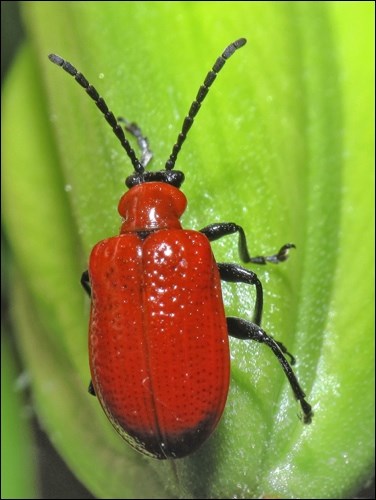Canadian prairie gardeners can be proud of the many early plant breeders who developed hardy, drought-tolerant, disease-resistant Asiatic lily hybrids in a vast array of colours and heights that we enjoy today. I’d much rather write about these lilies than the lily beetle (Lilioceris lilii). But if left uncontrolled, the lily beetle could destroy both our garden lilies and fritillarias.
The beetle first arrived in eastern Canada in the 1940s and has been slowly making its way west. Until recently, Saskatchewan had escaped its onslaught. But it was sighted in several communities in 2015 including Saskatoon, Tisdale and Leask.
It is unmistakable: bright red, with a black head, large black eyes, long black antennas, eight to10 millimetres long and oval in shape. When in distress, it can “squeak” to warn off predators (or gardeners). Adult beetles over winter in the soil or under leaf litter, often near the plants they feed on. They emerge in late April or early May and soon settle down to feed and mate.
Females lays two to 16 reddish-orange eggs on the underside of lily leaves in an irregular line. These hatch within eight to 10 days. Newly hatched larvae are black, while older stages are yellowish-white with a black head. The lily beetle larvae deposit their feces on their back (this is called a “fecal shield”), a protection against the heat of the sun and to disguise itself from predators. The larvae feed for about three weeks and can devour entire lily plants. Once mature, they enter the soil, change to an orange colour, pupate and emerge as adults after three weeks. At this point, they feed on lilies until cold weather sets in, when they head back underground to over winter.
The lily beetle has no natural enemies in North America. In Europe, a parasitoid wasp, Tetrastichus setifer, controls them. This wasp has been released in eastern Canada where it is beginning to control the lily beetle. More recently, it has been released in Alberta in Olds, St. Albert and Calgary.
For lily-loving gardeners, the best control of the lily beetle is a non-chemical approach as broad-spectrum insecticides kill both the beetle and its predators. Be observant: as soon your lilies emerge in the spring, check them regularly for signs of beetles, eggs and larvae. The most effective means to control beetles is to handpick (or squish eggs and larvae). If you’re already feeling squeamish, wear gloves, carry a pail of warm soapy water to drop the beetles into, or bribe a less sensitive 10-year old. Insecticidal soap is an effective larvacide.
Don’t accidentally import lily beetles. Un-pot potted lilies over newspaper and check the media carefully for eggs, larvae or adults. A much safer bet is to plant washed bulbs from a reputable source. Before planting, soak the bulbs for a few minutes in a 10 per cent bleach solution to kill any critters hiding in the scales.
Historically, Easter lilies have been one of the sources of lily beetles in western Canada. While fine in the home, do not plant them in the garden. Besides, the beetles are much more likely to over winter than the Easter lilies.
If you sight the lily beetle, its eggs or larvae, please report your sighting to www.biodiversity.sk.ca/invasives.htm.
The Canadian Prairie Lily Society is an excellent source of information as well as lily bulbs. Their 50th Annual Lily Show will be held July 22 and 23 and the fall bulb sale Sept. 30 and Oct. 1 – both events at Lawson Heights Mall in Saskatoon.
Honeywood Nursery (http://honeywood-lilies.ca) in Parkside, where Bert Porter bred so many heritage Asiatic lilies, is now a non-profit provincial heritage site. With lilies, day lilies, other perennials and rhubarb for sale, Honeywood will be open daily from May 21 to Sept. 18. See website for special events in 2016.
— This column is provided courtesy of the Saskatchewan Perennial Society (www.saskperennial.ca; hortscene@yahoo.com; www.facebook.com/saskperennial). Check out our Bulletin Board or Calendar for upcoming garden information sessions, workshops and tours: May 6 – 8 Horticulture workshops at the University of Saskatchewan (306-966-5539 for details)



